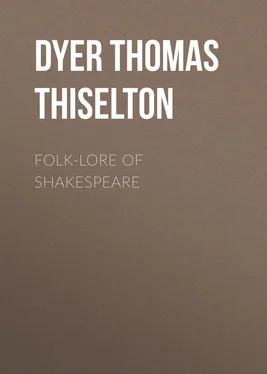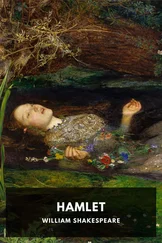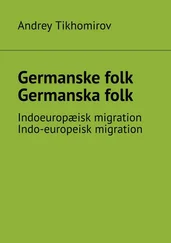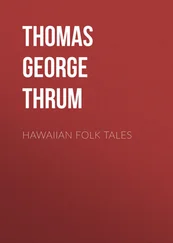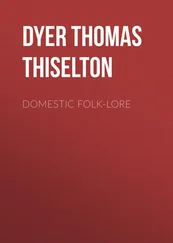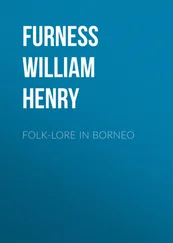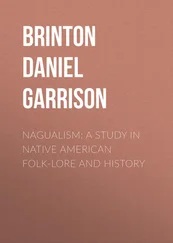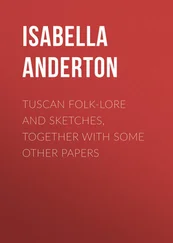Thomas Dyer - Folk-lore of Shakespeare
Здесь есть возможность читать онлайн «Thomas Dyer - Folk-lore of Shakespeare» — ознакомительный отрывок электронной книги совершенно бесплатно, а после прочтения отрывка купить полную версию. В некоторых случаях можно слушать аудио, скачать через торрент в формате fb2 и присутствует краткое содержание. Жанр: foreign_antique, foreign_prose, на английском языке. Описание произведения, (предисловие) а так же отзывы посетителей доступны на портале библиотеки ЛибКат.
- Название:Folk-lore of Shakespeare
- Автор:
- Жанр:
- Год:неизвестен
- ISBN:нет данных
- Рейтинг книги:4 / 5. Голосов: 1
-
Избранное:Добавить в избранное
- Отзывы:
-
Ваша оценка:
- 80
- 1
- 2
- 3
- 4
- 5
Folk-lore of Shakespeare: краткое содержание, описание и аннотация
Предлагаем к чтению аннотацию, описание, краткое содержание или предисловие (зависит от того, что написал сам автор книги «Folk-lore of Shakespeare»). Если вы не нашли необходимую информацию о книге — напишите в комментариях, мы постараемся отыскать её.
Folk-lore of Shakespeare — читать онлайн ознакомительный отрывок
Ниже представлен текст книги, разбитый по страницам. Система сохранения места последней прочитанной страницы, позволяет с удобством читать онлайн бесплатно книгу «Folk-lore of Shakespeare», без необходимости каждый раз заново искать на чём Вы остановились. Поставьте закладку, и сможете в любой момент перейти на страницу, на которой закончили чтение.
Интервал:
Закладка:
The pretence, also, of predicting events, such as pestilence, from the aspect of the heavenly bodies – one form of medical astrology – is noticed in “Venus and Adonis:”
“Long may they kiss each other, for this cure!
O, never let their crimson liveries wear!
And as they last, their verdure still endure,
To drive infection from the dangerous year!
That the star-gazers, having writ on death,
May say, the plague is banish’d by thy breath!”
Heroes were in ancient times immortalized by being placed among the stars, a custom to which Bedford refers in “1 Henry VI.” (i. 1):
“A far more glorious star thy soul will make
Than Julius Cæsar.”
And, again, “Pericles” (v. 3) exclaims:
“Heavens make a star of him.”
On a medal of Hadrian, the adopted son of Trajan and Plotina, the divinity of his parents is expressed by placing a star over their heads; and in like manner the medals of Faustina the Elder exhibit her on an eagle, her head surrounded with stars. 127 127 Douce’s “Illustrations of Shakespeare,” 1839, p. 397.
In “2 Henry IV.” (iv. 3) a ludicrous term for the stars is, “cinders of the elements;” and in “Merchant of Venice” (v. 1) they are designated “candles of the night.”
Meteors. An elegant description of a meteor well known to sailors is given by Ariel in “The Tempest” (i. 2):
“sometime I’d divide
And burn in many places; on the topmast,
The yards, and bowsprit, would I flame distinctly,
Then meet and join.”
It is called, by the French and Spaniards inhabiting the coasts of the Mediterranean, St. Helme’s or St. Telme’s fire; by the Italians, the fire of St. Peter and St. Nicholas. It is also known as the fire of St. Helen, St. Herm, and St. Clare. Douce 128 128 Ibid. p. 3.
tells us that whenever it appeared as a single flame it was supposed by the ancients to be Helena, the sister of Castor and Pollux, and in this state to bring ill luck, from the calamities which this lady is known to have caused in the Trojan war. When it came as a double flame it was called Castor and Pollux, and accounted a good omen. It has been described as a little blaze of fire, sometimes appearing by night on the tops of soldiers’ lances, or at sea on masts and sailyards, whirling and leaping in a moment from one place to another. According to some, it never appears but after a tempest, and is supposed to lead people to suicide by drowning. Shakespeare in all probability consulted Batman’s “Golden Books of the Leaden Goddes,” who, speaking of Castor and Pollux, says: “They were figured like two lampes or cresset lightes – one on the toppe of a maste, the other on the stemme or foreshippe.” He adds that if the first light appears in the stem or foreship and ascends upwards, it is a sign of good luck; if “either lights begin at the topmast, bowsprit,” or foreship, and descends towards the sea, it is a sign of a tempest. In taking, therefore, the latter position, Ariel had fulfilled the commands of Prospero, and raised a storm. 129 129 See Brand’s “Pop. Antiq.,” 1849, vol. iii. p. 400.
Mr. Swainson, in his “Weather-Lore” (1873, p. 193), quotes the following, which is to the same purport:
“Last night I saw Saint Elmo’s stars,
With their glittering lanterns all at play,
On the tops of the masts and the tips of the spars,
And I knew we should have foul weather that day.”
Capell, in his “School of Shakespeare” (1779, iii. 7), has pointed out a passage in Hakluyt’s “Voyages” (1598, iii. 450), which strikingly illustrates the speech of Ariel quoted above: “I do remember that in the great and boysterous storme of this foule weather, in the night, there came vpon the toppe of our maine yarde and maine maste, a certaine little light, much like unto the light of a little candle, which the Spaniards called the Cuerpo-Santo, and said it was St. Elmo, whom they take to bee the aduocate of sailers… This light continued aboord our ship about three houres, flying from maste to maste, and from top to top; and sometimes it would be in two or three places at once.” This meteor was by some supposed to be a spirit; and by others “an exhalation of moyst vapours, that are ingendered by foul and tempestuous weather.” 130 130 Purchas, “His Pilgrimes” (1625, pt. i. lib. iii. p. 133), quoted by Mr. Aldis Wright in his “Notes to The Tempest,” 1875, p. 86.
Mr. Thoms, in his “Notelets on Shakespeare” (1865, p. 59), says that, no doubt, Shakespeare had in mind the will-o’-the-wisp. 131 131 See Puck as Will-o’-the-Wisp ; chapter on “Fairy-Lore.”
Fire-Drake , which is jocularly used in “Henry VIII.” (v. 4) for a man with a red face, was one of the popular terms for the will-o’-the-wisp, 132 132 See “Notes and Queries,” 5th series, vol. x. p. 499; Brand’s “Pop. Antiq.,” 1849, vol. iii. p. 410; Nares’s “Glossary,” vol. i. p. 309.
and Burton, in his “Anatomy of Melancholy,” says: “Fiery spirits or devils are such as commonly work by fire-drakes, or ignes fatui, which lead men often in flumina et præcipitia.” In Bullokar’s “English Expositor” (1616), we have a quaint account of this phenomenon: “Fire-drake; a fire sometimes seen flying in the night like a dragon. Common people think it a spirit that keepeth some treasure hid, but philosophers affirme it to be a great unequal exhalation inflamed betweene two clouds, the one hot, the other cold, which is the reason that it also smoketh, the middle part whereof, according to the proportion of the hot cloud being greater than the rest, maketh it seem like a bellie, and both ends like unto a head and taill.” 133 133 A “fire-drake” appears to have been also an artificial firework, perhaps what is now called a serpent. Thus, in Middleton’s “Your Five Gallants” (1607): “But, like fire-drakes, Mounted a little, gave a crack and fell.”
White, however, in his “Peripateticall Institutions” (p. 156), calls the fiery-dragon or fire-drake, “a weaker kind of lightning. Its livid colors, and its falling without noise and slowly, demonstrate a great mixture of watery exhalation in it… ’Tis sufficient for its shape, that it has some resemblance of a dragon, not the expresse figure.”
Among other allusions to the will-o’-the-wisp by Shakespeare, Mr. Hunter 134 134 “New Illustrations of the Life, Studies, and Writings of Shakespeare,” vol. ii. p. 272.
notices one in “King Lear” (iii. 4), where Gloster’s torch being seen in the distance, the fool says, “Look, here comes a walking fire.” Whereupon Edgar replies, “This is the foul fiend, Flibbertigibbet; he begins at curfew, and walks till the first cock.” “From which,” observes Mr. Hunter, “Flibbertigibbet seems to be a name for the will-o’-the-wisp. Hence the propriety of ‘He begins at curfew , and walks till the crowing of the cock,’ that is, is seen in all the dark of the night.” It appears that when Shakespeare wrote, “a walking fire” was a common name for the ignis fatuus , as we learn from the story of “How Robin Goodfellow lead a company of fellows out of their way:” “A company of young men, having been making merry with their sweethearts, were, at their coming home, to come over a heath; Robin Goodfellow, knowing of it, met them, and to make some pastime hee led them up and downe the heathe a whole night, so that they could not get out of it, for hee went before them in the shape of a walking fire , which they all saw and followed till the day did appeare; then Robin left them, and at his departure spake these words:
Интервал:
Закладка:
Похожие книги на «Folk-lore of Shakespeare»
Представляем Вашему вниманию похожие книги на «Folk-lore of Shakespeare» списком для выбора. Мы отобрали схожую по названию и смыслу литературу в надежде предоставить читателям больше вариантов отыскать новые, интересные, ещё непрочитанные произведения.
Обсуждение, отзывы о книге «Folk-lore of Shakespeare» и просто собственные мнения читателей. Оставьте ваши комментарии, напишите, что Вы думаете о произведении, его смысле или главных героях. Укажите что конкретно понравилось, а что нет, и почему Вы так считаете.
